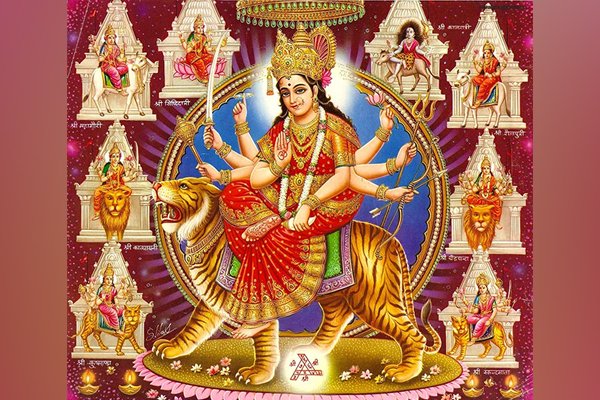One of the most important and auspicious Hindu festivals, Navratri, marks the arrival of Goddess Durga on earth. Every year, Shardiya Navratri is celebrated in the Hindu month of Ashwin after Mahalaya Amavasya. Sharadiya Navratri 2021 will be celebrated after the end of Pitru Paksha. Navratri, a major Hindu festival, is a celebration of good over evil and is celebrated each day to mark the nine incarnations of Goddess Durga.

Navratri 2021 will start from 7th October and will continue till 15th October. Various pandals have been set up across the country and people offer special food and worship to the nine forms of Goddess Durga. On the auspicious occasion of Navratri, people worship the nine incarnations of Goddess Durga, Shailputri, Brahmacharini, Chandraghanta, Kushmanda, Skandmata, Katyayani, Kalratri, Mahagauri and Siddhidatri.
Kalash installation date and time
The festivities of Navratri begin with Ghatasthapana or Kalash installation and the devotees observe a fast for nine days. They recite Devi Mahatmyam and chant sacred mantras dedicated to the Mother Goddess. This year, Kalash Sthapana will be done on October 7, 2021, and the timings are from 9.33 am to 11.31 am. Apart from this, Kalash installation can also be done from 3.33 pm to 5.05 pm.
How to set up a vase
To establish the Kalash, one should wake up early in the morning and wear new clothes. The place where the worship is to be performed should be done thoroughly. Take an earthen pot and spread a layer of soil on it and then spread the seeds of cereals. Then, add a second layer of soil and sprinkle some water to set it.
Tie a sacred thread around the neck of the Kalash and fill it with holy water. Put betel nut, gandh, akshat, durva grass and coins in the water. Place five mango leaves over it on the edge of the Kalash and then cover it with a lid. Now wrap a coconut in a red cloth and tie it with a sacred thread. Place it on top of the vase. Now it is ready to invoke Goddess Durga. Worship and request Goddess Durga to accept it and reside in the Kalash for nine days of Navratri.
Kalash worship method
The Kalash should show a lamp and incense. Offer flowers, fragrance, fruits and sweets to the Kalash and finish the first phase of the puja. Now recite Durga Puja mantras and do Aarti of Maa Durga.
Worship Method and Date for Worshiping the Nine Avatars of Goddess Durga
October 7: Devotees perform Ghatasthapana and Shailputri Puja on Pratipada Tithi. Goddess Shailputri is the first form of Goddess Durga who adorns a trident and a lotus in her hand. On this day, people offer pure desi ghee to Goddess Shailputri, who is also an incarnation of Goddess Parvati.
October 8: On Dwitiya Tithi, people worship Brahmacharini, another form of Goddess Durga. It is believed that after a long penance, Goddess Parvati got Lord Shiva as her husband, hence the name Brahmacharini. This incarnation of Durga is a symbol of nobility and atonement and she is offered offerings of sugar and fruits.
October 9: Chandraghanta Puja and Kushmanda Puja should be done on Tritiya and Chaturthi. Goddess Chandraghanta is the third incarnation of Goddess Durga who is furious and angry with 10 arms. She is served sweets made of kheer and milk and on the other hand, Malpua is offered as bhog to the fourth form of Goddess Kushmanda.
October 10: On Panchami Tithi, people worship Skandmata and this day is also known as Panchami. Goddess Skandamata is the fifth incarnation of Goddess Durga and is a calm and serene goddess. Devotees serve bananas as prasad to the goddess on this day as a sign of good health.
October 11: Katyayani Puja should be performed for Shashi Tithi. On the sixth day of the festival, Goddess Durga is offered honey, symbolizing sweetness. It is believed that Goddess Katyayani blesses people with a sweet life and is a symbol of true devotion.
October 12: Kalratri Puja is performed on Saptami Tithi, the seventh incarnation of Goddess Durga. According to Hindu mythology, people offer jaggery to Goddess Durga on Saptami and it is believed that she protects her true devotees from evil spirits and power.
October 13: Mahagauri Puja is performed on Ashtami Tithi and devotees worship Goddess Durga by offering coconut as bhog. Goddess Maggauri rides a bull and is considered a symbol of perseverance and penance.
October 14: On Navami Tithi, Siddhidatri Puja is performed and this day is celebrated as Navami. The ninth form of Goddess Durga is a symbol of wisdom and knowledge and is served in the form of til or sesame seeds as a form of bhog.
October 15: On Dashami Tithi, devotees perform Navratri Parana or Durga Visarjan. Vijayadashami marks the end of Navratri every year. On the last day, the idols are taken in a procession and immersed in water.
